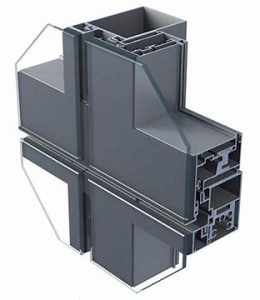Sale price list and implementation of curtain wall profile

Sale price list and implementation of curtain wall profile ,In the realm of modern architecture, the curtain wall system stands as a testament to innovation and functionality. Offering a seamless blend of aesthetics and structural integrity, curtain walls have become a staple in contemporary building design. These systems not only enhance the visual appeal of structures but also contribute significantly to energy efficiency and environmental sustainability. However, navigating the complexities of selecting and implementing curtain wall profiles can be daunting for architects and builders. To streamline this process, the integration of a comprehensive sale price list alongside meticulous implementation strategies becomes paramount.
Understanding Curtain Wall Profiles
Curtain wall profiles form the backbone of any curtain wall system. These profiles, typically made of aluminum or steel, serve as the framework onto which glazing panels are attached. The choice of profiles plays a crucial role in determining the overall performance and appearance of the curtain wall. From standard mullions and transoms to custom-designed profiles, architects have a plethora of options at their disposal.
Importance of Sale Price List
In an industry driven by precision and cost-efficiency, having access to a comprehensive sale price list for curtain wall profiles is indispensable. Such a list provides architects and builders with vital information regarding the specifications, dimensions, and pricing of various profiles offered by manufacturers. Armed with this knowledge, stakeholders can make informed decisions tailored to the unique requirements of each project.
Factors Influencing Sale Price
Several factors influence the sale price of curtain wall profiles:
- Material: The choice between aluminum and steel profiles can significantly impact the overall cost. While aluminum profiles are lightweight and corrosion-resistant, steel profiles offer superior strength but at a higher price point.
- Complexity: Custom-designed profiles tailored to specific architectural designs may entail higher manufacturing costs compared to standard profiles.
- Size and Quantity: Larger profiles and bulk orders often entail volume discounts, whereas smaller quantities may incur additional surcharges.
- Finishes: Different finishes, such as anodized, powder-coated, or painted, can influence the price of curtain wall profiles.
Implementation Strategies
Efficient implementation of curtain wall profiles requires meticulous planning and execution:
- Design Integration: Collaborate closely with architects and engineers to ensure seamless integration of curtain wall profiles with the overall building design.
- Material Selection: Choose profiles that strike a balance between aesthetics, performance, and cost-effectiveness.
- Quality Assurance: Prioritize manufacturers known for producing high-quality profiles that adhere to industry standards and regulations.
- Installation Expertise: Employ experienced contractors proficient in the installation of curtain wall systems to guarantee optimal performance and longevity.
Continuous Innovation in Curtain Wall Technology
As the architectural landscape evolves, so too does curtain wall technology. Manufacturers continually strive to innovate, offering new materials, finishes, and design options to meet the evolving needs of the industry. From advanced thermal breaks for enhanced energy efficiency to integrated smart technologies for automated control systems, the possibilities for curtain wall systems are ever-expanding.
Sustainable Considerations
In an era increasingly defined by environmental consciousness, sustainability has become a central consideration in architectural design. Curtain wall profiles play a crucial role in achieving sustainable building goals by facilitating natural light penetration, optimizing thermal performance, and reducing reliance on artificial heating and cooling systems. Furthermore, the use of recyclable materials and energy-efficient manufacturing processes further enhances the sustainability credentials of curtain wall systems.
Future Trends and Challenges
Looking ahead, the future of curtain wall technology holds immense promise. Advancements in materials science, digital fabrication techniques, and building automation are poised to revolutionize the way curtain wall systems are designed, fabricated, and installed. However, alongside these opportunities come challenges, including ensuring compatibility with evolving building codes and regulations, addressing concerns related to building resilience and safety, and mitigating the environmental impact of manufacturing processes.
Conclusion: Embracing Innovation for a Brighter Future
In conclusion, the sale price list and implementation of curtain wall profiles represent essential components of modern architectural practice. By leveraging comprehensive price lists and adopting meticulous implementation strategies, architects and builders can unlock the full potential of curtain wall systems, achieving a harmonious balance between aesthetics, performance, and sustainability. As the industry continues to evolve, embracing innovation and embracing sustainable practices will be paramount in shaping the built environment of tomorrow. Through collaboration, creativity, and a commitment to excellence, we can build a future where architectural beauty coexists harmoniously with environmental stewardship.





Leave A Comment